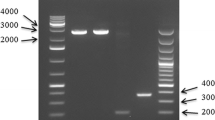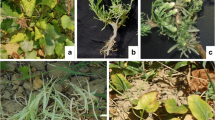Abstract
Transmission of three strains of OMMV by an Olpidium sp. was evaluated and compared. The three strains were 1) an OMMV wild type (WT) recovered from olive trees, 2) an OMMV variant (L11) obtained after 15 serial passages of single local lesions induced in Chenopodium murale plants, and 3) a construct OMMV/OMMVL11 in which the coat protein (CP) gene replaced that of the wild type. A single-sporangial culture derived from Chinese cabbage (Brassica pekinensis) used as a bait plant grown in soil of an olive orchard, was identified as Olpidium brassicae based on the size and sequence of the generated amplicon in PCR specific tests. Each of the three virus strains was soil transmitted to cabbage roots in the absence of the fungus at similar rates of 30 to 40%. Separate plant inoculation by O. brassicae zoospores incubated with each viral strain resulted in enhanced transmission of OMMV, reaching 86% of infection whereas that of the other two strains remained practically unaffected at ca. 34%. Binding assays showed that the amount of virus bound to zoospores, estimated spectrophotometrically, was 7% in the case of OMMV, and practically nil in the case of the other two viral strains. Substitution of the coat protein (CP) gene of OMMV by that of the OMMV L11 strain, drastically reduced viral transmissibility in the presence of zoospores to the level of that observed in their absence. Our data shows that OMMV soil transmission is greatly enhanced by O. brassicae zoospores and that the viral CP plays a significant role in this process, most likely by facilitating virus binding and later entrance into the host plant roots.




Similar content being viewed by others
References
Brown, D. J. F., Robertson, W. M., & Trudgill, D. L. (1995). Transmission of viruses by plant nematodes. Annual Review of Phytopathology, 33, 223–249.
Campbell, R. N. (1996). Fungal transmission of plant viruses. Annual Review of Phytopathology, 34, 87–108.
Cardoso, J. M. S., Félix, M. R., Clara, M. I. E., & Oliveira, S. (2005). The complete genome sequence of a new necrovirus isolated from Olea europaea L. Archives of Virology, 150, 815–823.
Clark, M. F., & Adams, A. N. (1977). Characteristics of microplate method of enzyme-linked immunosorbent assay for detection of plant-viruses. The Journal of General Virology, 34, 475–483.
Fry, E. E., Lea, S. M., Jackson, T., Newman, J. W. I., Ellard, R. M., Blakemore, W. E., et al. (1999). The structure of a foot-and-mouth disease virus-oligosaccharide receptor complex. The EMBO Journal, 18, 543–554.
Gray, S. M. (1996). Plant virus protein involved in natural vector transmission. Trends in Microbiology, 4, 259–264.
Gray, S. M., & Rochon, D. M. (1999). Vectors of plant viruses. In A. Granoff & R. Webster (Eds.), Encyclopedia of virology, vol. 1 (pp. 1899–1910). London: Academic Press.
Herrera-Vásquez, J. A., Cebrián, M. C., Alfaro-Fernández, A., Córdoba-Sellés, M. C., & Jordá, C. (2009). Multiplex PCR assay for the simultaneous detection and differentiation of Olpidium bornovanus, O. brassicae, and O. virulentus. Mycological Research, 113, 602–610.
Kakani, K., Robbins, M., & Rochon, D. (2003). Evidence that binding of cucumber necrosis virus to vector zoospores involves recognition of oligosaccharides. Journal of Virology, 77, 3922–3928.
Kakani, K., Reade, R., & Rochon, D. (2004). Evidence that vector transmission of a plant virus requires conformational change in virus particles. Journal of Molecular Biology, 338, 507–517.
Kassanis, B. (1949). A necrotic disease of forced tulips caused by tobacco necrosis viruses. The Annals of Applied Biology, 36, 14–17.
Lange, L., & Insunza, V. (1977). Root-inhabiting Olpidium species: the O.radicale complex. Transactions of the British Mycological Society, 69, 377–384.
Lin, M. T., Campbell, R. N., Smith, P. R., & Temmink, J. H. M. (1970). Lettuce big-vein virus transmission by single-sporangium isolates of Olpidium brassicae. Phytopathology, 60, 1630–1634.
McLean, M. A., Campbell, R. N., Hamilton, R. I., & Rochon, D. M. (1994). Involvement of the cucumber necrosis virus coat protein in the specificity of fungus transmission by Olpidium bornovanus. Virology, 204, 840–842.
Robbins, M. A., Reade, R. D., & Rochon, D. M. (1997). A cucumber necrosis virus variant deficient in fungal transmissibility contains an altered coat protein shell domain. Virology, 234, 138–146.
Rossman, M. G. (1994). Viral cell recognition and entry. Protein Science, 3, 1712–1725.
Skehel, J. J., & Wiley, D. C. (2000). Receptor binding and membrane fusion in virus entry: the influenza virus hemagglutinin. Annual Review of Biochemistry, 69, 531–569.
Temmink, J. H. M., Campbell, R. N., & Smith, P. R. (1970). Specificity and site of in vitro acquisition of tobacco necrosis virus by zoospores of Olpidium brassicae. The Journal of General Virology, 9, 201–213.
Pham, K. T. K., Lemmers, M. E. C., van Doorn, J., & Derks, A. F. L. M. (unpublished). Revision of taxonomy of the virus causing Augusta disease in tulips in the Netherlands.
Phillip, J. M., & Hayman, D. S. (1970). Improved procedure for clearing roots and staining parasitic and vesicular-arbuscula mycorrhizal fungi for rapid assessment of infection. Transactions of the British Mycological Society, 55, 158.
Pirone, T. P., & Blanc, S. (1996). Helper dependent vector transmission of plant viruses. Annual Review of Phytopathology, 34, 227–247.
Van den Heuvel, J. F. J. M., Hogenhout, S. A., & van der Wilk, F. (1999). Recognition and receptors in virus transmission by arthropods. Trends in Microbiology, 7, 71–76.
Varanda, C., Cardoso, J. M. S., Félix, M. R., Oliveira, S., & Clara, M. I. (2010). Multiplex RT-PCR for detection and identification of three necroviruses that infect olive trees. European Journal of Plant Pathology, 127, 161–164.
Zhang, L., French, R., & Langenberg, W. G. (1993). Molecular-cloning and sequencing of the coat protein gene of a Nebraskan isolate of Tobacco necrosis virus - the deduced coat protein-sequence has only moderate homology with those of strain-A and strain-D. Archives of Virology, 132, 291–305.
Acknowledgments
The authors would like to thank Ron Reade (Agriculture and Agri-Food Canada) for many helpful discussions, to José Ángel Herrera-Vásquez (Universidad Politécnica de Valencia, Spain) for providing DNA from O. brassicae and O. virulentus to use as controls, to Maria Mário Azedo for her technical assistance and to Alan Phillips (Universidade Nova de Lisboa) for critical reading of the manuscript and helpful advice. Carla Marisa R. Varanda is recipient of a PhD fellowship from Fundação para a Ciência e a Tecnologia (FCT), SFRH/BD/29398/2006 and Marta Silva is recipient of a FCT fellowship, UUE/ICAAM/BII/04 A/2009.
Author information
Authors and Affiliations
Corresponding author
Rights and permissions
About this article
Cite this article
Varanda, C.M.R., Silva, M.S.M.R., Félix, M.d.F. et al. Evidence of olive mild mosaic virus transmission by Olpidium brassicae . Eur J Plant Pathol 130, 165–172 (2011). https://doi.org/10.1007/s10658-011-9742-1
Accepted:
Published:
Issue Date:
DOI: https://doi.org/10.1007/s10658-011-9742-1




